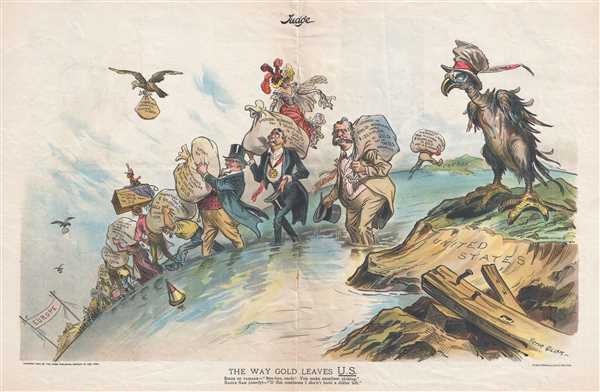1897 Gillam Political Cartoon Satirizing America's Economic Woes
GoldLeavesUS-gillam-1897
Title
1897 (dated) 12.5 x 19 in (31.75 x 48.26 cm)
Description
A Closer Look
The cartoon depicts a line of foreign citizens (all but one of them European) taking American gold out of the United States and back to Europe or Canada. The United States is depicted as an eagle that has had nearly all of its feathers plucked while sporting a ratty top hat with a ribbon that reads 'hard times.' All the Europeans, of course, are smartly dressed and boasting smiles, 'thanking' their 'uncle' for the wealth they are taking home with them. Judge supported William McKinley's successful 1897 McKinley run for president. The American economy coincidentally began to recover that year, partially due to the Klondike Gold Rush.The Panic of 1893
The Panic of 1893 set off the worst economic depression to hit the United States until the Great Depression. At the peak of the Panic, unemployment ranged from 17 - 19% of the American workforce. There was no clear cause for the Panic, but most point to speculation in the investment market. For whatever reason, when these investments began to fail, either due to droughts suffered by the farmers or the bankruptcy of the Philadelphia and Reading Railroad, creditors began to panic.As well, in 1893, the U.S. Dollar was on the bimetal standard, meaning that dollars could be exchanged directly for gold or silver. Due to silver bonanzas in Colorado and Nevada, U.S. markets were flooded with silver coinage and certificates - leading to fears that silver would be devalued vs gold. The American public and foreign creditors, concerned about the silver glut, crop failures, and the titanic bankruptcy of the overextended Philadelphia and Reading Railroad, began exchanging their dollars for gold. A run on the banks ensued, which depleted the U.S. Treasury to the minimum required by law. This, in turn, led to hundreds of bank failures and bankruptcies by private companies. In the end, President Cleveland had to borrow $65 million in gold from J.P. Morgan to support the gold standard.
The American economy began to recover in 1897. The election of President McKinley renewed confidence in the government, and the Klondike Gold Rush launched ten years of rapid economic growth. At least until the Panic of 1907.
Publication History and Census
This cartoon was drawn by Victor Gillam and published by Judge in 1897. It was originally a centerfold in the June 12, 1897 issue of Judge and appears to be reasonably rare. We have been unable to locate any other examples.Cartographer
Frederick Victor Gillam (c. 1858 - January 29, 1920) was an American political cartoonist, best known for his work in Judge magazine. His work was also published in The St. Louis Dispatch, Denver Times, New York World and New York Globe. He was born in Yorkshire, England and his family immigrated to the United States when Gillam was six year old. His older brother Bernhard Gillam (1856 - 1896) was a famous cartoonist as well, leading Gillam to sign his work 'Victor' or F. Victor' until his brother's death. He was also a member of the New York Press Club and New York Lotos Club. Gillam died in Brooklyn, New York on January 29, 1920. More by this mapmaker...

